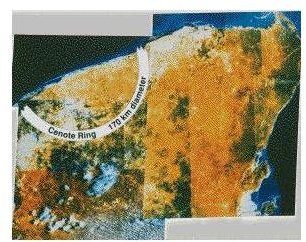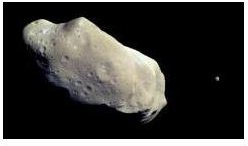Types and Risks of Near Earth Objects: Tracking of NEO's
Not Science Fiction
The idea that a giant asteroid might smash into Earth sounds like the stuff of science fiction, but – unlike a rampaging Godzilla or an attack of robot armies from the future – a cosmic crash with our planet is a very real, though not extremely likely, possibility.
In the Beginning
As advances in space exploration in the ’70s, ’80s and ’90s made it increasingly clear how many asteroids and comets travel the Solar System, U.S. officials began taking notice. In 1990, Congress directed NASA to conduct two studies on NEOs, or “Near-Earth Objects.” Four years later, Washington told NASA to begin working with the Defense Department and international agencies to find and catalogue potentially dangerous NEOs. In 1998, that job became the explicit task of a new agency: the Near-Earth Object Program Office at NASA’s Jet Propulsion Laboratory.
Since then, researchers at the Near-Earth Object Program have been working diligently to identify and track at least 90 percent of the larger (1 kilometer, or about 2/3 of a mile, in diameter) asteroids and comets that could cross Earth’s orbit and cause a possible impact.
“These are objects that are difficult to detect because of their relatively small size, but are large enough to cause global effects if one hit the Earth,” said Near-Earth Object Program chief Donald Yeomans upon the establishment of the agency 10 years ago.
Close-Up Photo of an Asteroid
An image of the asteroid 243 Ida, taken by the imaging system on the Galileo spacecraft in 1993. The asteroid was about 6,500 miles (10,500 kilometers) away from Galileo.
Photo credit: https://neo.jpl.nasa.gov/images/ida.html
Identifying Potentially Hazardous Asteroids
Since the program started, the Near-Earth Object effort has identified more than 5,500 (to be exact, 5,576 as of Aug. 19, 2008) NEOs. Some are comets, bodies of mostly water ice and dust born in the frozen outer regions of the Solar System more than four billion years ago. Others are asteroids, chunks of rocks that formed on the outskirts of the rocky planets (Mercury, Venus, Earth and Mars) during those same early days.
Of all the NEOs found so far, 966 have been designated as “Potentially Hazardous Asteroids,” or PHAs. PHAs earned their designation from the fact they have the greatest potential to come close to Earth and, if they collide, cause catastrophic harm to life on our planet.
By definition, a PHA has an orbit that could bring it 7.48 million kilometers (4.65 million miles) or closer to the place we humans call home. PHAs are also at least 150 meters (about 500 feet) across, a size that could cause some serious damage upon striking the Earth’s surface.
Why Bother Tracking NEOs?
Why search for and track NEOs at all? After all, the Earth is still pelted regularly by leftover bits from the Solar System’s formation. As long as those bits range in size from dust-like to about 50 meters (164 feet) across, there’s not much to worry about: the speed at which they enter the Earth’s atmosphere typically causes them to burn up or disintegrate before impact.
But larger NEOs? We have a reason to worry about the danger they pose upon crossing our path.
For example, an object a little more than 50 meters in diameter could devastate any community in its immediate path (the 1908 Tunguska impact event might be one instance of a collision with an object of this size). On the other hand, if an NEO that size landed in an ocean area, it could generate powerful tsunamis with deadly results for coastal settlements.
NEOs on the order of one kilometer or so across would be even more cataclysmic upon impact. An object that size could cause massive firestorms and blast huge amounts of debris into the atmosphere, leading to acid rain, blocked sunlight and a severe threat to plant (and, by default, animal and human) life around the globe.
For impacting NEOs larger than that? Don’t ask. Cosmic objects that are 10 kilometers or more in diameter have “extinction-class” potential upon impact, according to scientists.
The good news is, there are fewer large NEOs than small ones, meaning the possibility of a catastrophic or extinction-class impact in our lifetimes is small. The bad news is, impacts large and small do happen over time which is why NASA continues tracking thousands of objects.
While objects between 5 and 10 meters across hit the Earth about once a year, one-kilometer NEOs tend to strike about once every 500,000 years. The last extinction-class sized object to hit us was probably the asteroid that struck what is now Mexico’s Yucatan Peninsula about 65 million years ago. The effects of that collision are believed to have contributed to the massive die-off of dinosaurs and other plant and animal species of the time.
Remains of an Ancient Impact

A radar image of the part of the buried Chicxulub impact crater on Mexico’s Yucatan Peninsula. The asteroid or comet that created the crater is believed to have been responsible, at least in part, for the massive die-off of many plant and animal species – including the dinosaurs – about 65 million years ago.
Photo credit: https://neo.jpl.nasa.gov/images/yucatan.html
NASA Authorization Act and NEO Threat Policies
Committees in the U.S. House of Representatives and the Senate passed the National Aeronautics and Space Administration Authorization Act of 2008 (a year that marks the 50th anniversary of the establishment of NASA). It was signed into law by the President on October 15, 2008.
The new Act requires - among other things - that NASA’s director of science and technology policy to “develop a policy for notifying federal agencies and relevant emergency response institutions of an impending NEO threat if near term public safety is at stake, to recommend a federal agency or agencies to be responsible for protecting the nation from a near-Earth object that is anticipated to collide with Earth and implementing a deflection campaign, in consultation with international bodies, should one be required.”
In other words, “If you spot an NEO heading our way, let us know and do something … fast!”
This post is part of the series: NEO’s - Near Earth Objects and the Hazards They Represent
This two part series discusses what objects are out there that we need to be concerned with and how we identify them. The second part of the series looks at the consequences of an impact.
